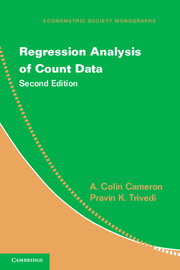Book contents
- Frontmatter
- Dedication
- Contents
- List of Figures
- List of Tables
- Preface
- Preface to the First Edition
- 1 Introduction
- 2 Model Specification and Estimation
- 3 Basic Count Regression
- 4 Generalized Count Regression
- 5 Model Evaluation and Testing
- 6 Empirical Illustrations
- 7 Time Series Data
- 8 Multivariate Data
- 9 Longitudinal Data
- 10 Endogenous Regressors and Selection
- 11 Flexible Methods for Counts
- 12 Bayesian Methods for Counts
- 13 Measurement Errors
- A Notation and Acronyms
- B Functions, Distributions, and Moments
- C Software
- References
- Author Index
- Subject Index
- Miscellaneous Endmatter
12 - Bayesian Methods for Counts
Published online by Cambridge University Press: 05 July 2014
- Frontmatter
- Dedication
- Contents
- List of Figures
- List of Tables
- Preface
- Preface to the First Edition
- 1 Introduction
- 2 Model Specification and Estimation
- 3 Basic Count Regression
- 4 Generalized Count Regression
- 5 Model Evaluation and Testing
- 6 Empirical Illustrations
- 7 Time Series Data
- 8 Multivariate Data
- 9 Longitudinal Data
- 10 Endogenous Regressors and Selection
- 11 Flexible Methods for Counts
- 12 Bayesian Methods for Counts
- 13 Measurement Errors
- A Notation and Acronyms
- B Functions, Distributions, and Moments
- C Software
- References
- Author Index
- Subject Index
- Miscellaneous Endmatter
Summary
INTRODUCTION
Bayesian methods provide a quite different way to view statistical inference and model selection and to incorporate prior information on model parameters. These methods have become increasingly popular over the past 20 years due to methodological advances, notably Markov chain Monte Carlo methods, and increased computational power.
Some applied studies in econometrics are fully Bayesian. Others merely use Bayesian methods as a tool to enable statistical inference in the classical frequentist maximum likelihood framework for likelihood-based models that are difficult to estimate using other methods such as simulated maximum likelihood.
Section 12.2 presents the basics of Bayesian analysis. Section 12.3 presents some results for Poisson models. Section 12.4 covers Markov chain Monte Carlo methods that are now the common way to implement Bayesian analysis when analytically tractable results cannot be obtained, and it provides an illustrative example. Section 12.5 summarizes Bayesian models for various types of count data. Section 12.6 concludes with a more complicated illustrative example, a count version of the Roy model that allows for endogenous selection.
BAYESIAN APPROACH
The Bayesian approach treats the parameters θ as unknown random variables, with inference on θ to be based both on the data y and on prior beliefs about θ. The data and prior beliefs are combined to form the posterior density of θ given y, and Bayesian inference is based on this posterior. This section presents a brief summary, with further details provided in subsequent sections.
Information
- Type
- Chapter
- Information
- Regression Analysis of Count Data , pp. 449 - 467Publisher: Cambridge University PressPrint publication year: 2013
